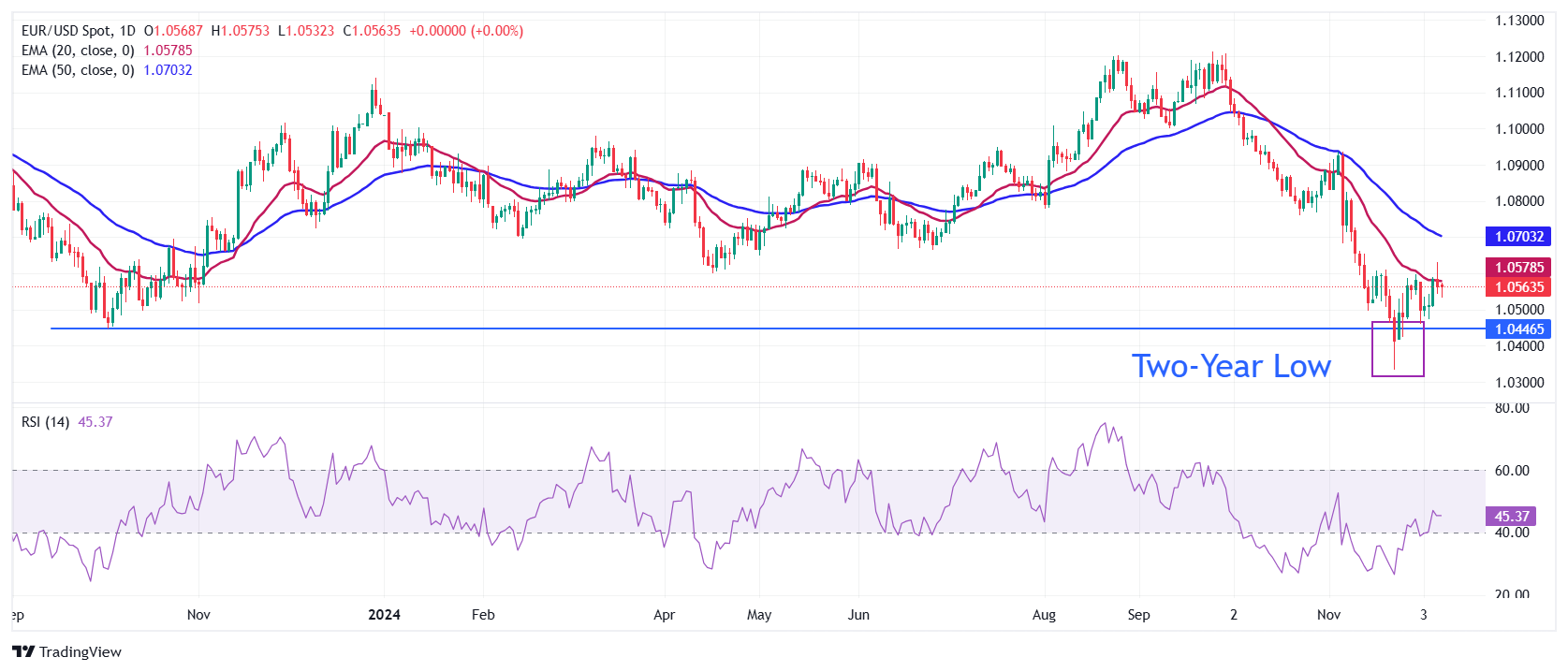EUR/USD turns sideways ahead of ECB policy meeting, US inflation data
- EUR/USD juggles near 1.0500 as investors await US CPI data for November and the ECB policy meeting.
- Investors expect the ECB to cut interest rates by 25 bps for the third time in a row.
- Fed Goolsbee forecasts the central bank to reach the neutral rate by the end of 2025.
EUR/USD consolidates around 1.0550 in Monday’s European session with investors focusing on the European Central Bank (ECB) monetary policy decision on Thursday. Markets are almost fully pricing in that the ECB will cut its Deposit Facility Rate by 25 basis points (bps) to 3% as many officials have shown concerns over risks of inflation undershooting the bank’s target due to the weak economic outlook.
The ECB has already reduced the deposit rate by 75 bps this year and Thursday’s rate-cut decision would be the third in a row.
Market participants expect the Eurozone economy to underperform amid political uncertainty in Germany and France, which are the largest nations of the bloc. The potential impact on the export sector when US President Donald Trump takes the administration at the White House is also a source of concern.
The French economy is going through a tough phase, and the outlook became gloomier after the government was toppled by lawmakers. Last week, Michel Barnier became the shortest-serving French prime minister after losing a no-confidence vote from the Far Right and the Left-Wing parties over his fiscal plans. French President Emmanuel Macron said that he will find a successor for Barnier “in the coming days.”
Daily digest market movers: EUR/USD consolidates amid firm Fed dovish bets
- EUR/USD trades sideways as the US Dollar (USD) struggles amid firm expectations that the Federal Reserve (Fed) will cut its key borrowing rates in its policy meeting on December 18. The US Dollar Index (DXY), which gauges the Greenback’s value against six major currencies, surrenders its gains generated in the Asian session and struggles to hold the key support of 106.00.
- According to the CME FedWatch tool, the probability for the Fed to cut interest rates by 25 bps to 4.25%-4.50% on December 18 has increased to 87% from 62% a week ago. Fed dovish bets escalated after the United States (US) Nonfarm Payrolls (NFP) report for November showed higher-than-expected hiring numbers.
- For the longer-term outlook on interest rates, Chicago Fed President Austan Goolsbee said on Friday that expects the central bank to reach the median rate by the end of next year. Goolsbee didn’t provide a specific number for the neutral rate but specified that a level around 3%, which is roughly the median that Fed officials projected as a stopping point at their September meeting, “doesn’t seem crazy.”
- This week, investors will focus on the US Consumer Price Index (CPI) data for November, which will be released on Wednesday. Economists expect the annual headline CPI to have accelerated to 2.7% from the October reading of 2.6%, with the core CPI – which excludes volatile food and energy items – growing steadily by 3.3%.
Technical Analysis: EUR/USD stays above 1.0500

EUR/USD wobbles above the psychological figure of 1.0500. The outlook of the major currency pair remains bearish as the 20-day EMA near 1.0580 acts as key resistance for the Euro (EUR) bulls.
The 14-day Relative Strength Index (RSI) rebounded after conditions turned oversold and has climbed above 40.00, suggesting that the bearish momentum has faded. However, the broader bearish trend for the pair doesn’t seem to be over yet.
Looking down, the November 22 low of 1.0330 will be a key support. On the flip side, the 50-day EMA near 1.0700 will be the key barrier for the Euro bulls.
Euro FAQs
The Euro is the currency for the 20 European Union countries that belong to the Eurozone. It is the second most heavily traded currency in the world behind the US Dollar. In 2022, it accounted for 31% of all foreign exchange transactions, with an average daily turnover of over $2.2 trillion a day, according to data from the Bank of International Settlements. EUR/USD is the most heavily traded currency pair in the world, accounting for an estimated 30% of all transactions, followed by EUR/JPY (4%), EUR/GBP (3%) and EUR/AUD (2%).

